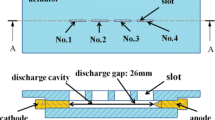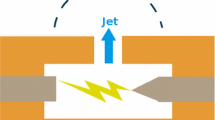Abstract
Performance characteristics of the jet produced by SparkJet actuator are investigated with a numerical simulation. The spark discharge is considered as a uniform heat source in energy equation modeled with a user-defined function in Fluent. The SparkJet actuator is tested with both single-spark pulse and dual-spark pulses. Validation with experiments for a single 50 mJ spark pulse shows that Joule heating factor for the heat source term is about 5%. Jet velocity increases and total impulse decreases with the distance of the spark from the exit orifice. Peak velocity and peak thrust increase with the volume of the spark discharge. Total impulse increases as the time delay between two temporally separated pulses increases. Spatially separated dual-spark pulses produce higher jet velocity as the time delay between the pulses increases. Performance testing of jets in various operating modes informs that the SparkJet actuator is more efficient and effective when spatiotemporally separated dual-spark pulses are turned on in downstroke operation with an adequate time delay between pulses.













Similar content being viewed by others
References
McCormick DC (1993) Shock/boundary-layer interaction control with vortex generators and passive cavity. AIAA J 31(1):91–96
Godard G, Stanislas M (2006) Control of a decelerating boundary layer. Part 1: Optimization of passive vortex generators. Aerosp Sci Tech 10(3):181–191
Lachmann GV (1961) Boundary layer and flow control its principles and application. Elsevier, Amsterdam
Neretti G (2016) Active flow control by using plasma actuators. Recent Progress in Some Aircraft Technologies, 57–76
Corke CT, Enloe CL, Wilkinson SP (2010) Dielectric barrier discharge plasma actuators for flow control. Annu Rev Fluid Mech 42:505–529
Cejas E, Mancinelli BR, Prevosto L (2019) Glow discharge in a high-velocity air flow: the role of the associative ionization reactions involving excited atoms. Materials 12:2524
Popkin S, Taylor T, Cybyk B (2013) Development and application of the sparkjet actuator for high-speed flow control. J Hopkins APL Tech Dig 32(1):404–418
Zimmerman JW, Palla A, Carroll DL, Hristov G, Ansell PJ (2017) Plasma actuator with arc breakdown in a magnetic field for active flow control applications. In: Paper presented at the 48th AIAA Plasmadynamics and Lasers Conference, AIAA 2017-3477, Denver, Colorado, USA, 5–9 June
Martin EA (1960) Experimental investigation of a high-energy density, high-pressure arc plasma. J Appl Phys 31(2):255–267
Bauder UH (1976) Properties of high pressure arc plasma. Appl Phys 9:105–115
Utkin YG, Keshav S, Kim JH, Kaster J, Adamovich IV, Samimy M (2006) Development and use of localized arc filament plasma actuators for high-speed flow control. J Phys D Appl Phys 40(3):685–694
Emerick T, Ali MY, Foster C, Alvi FS (2014) Sparkjet characterizations in quiescent and supersonic flowfields. Exp Fluids 55(12):1858
Kazanskii P, Moralev I, Firsov AA (2018) Active flow control by means of MHD plasma actuator in the curvilinear channel. In: Paper presented at the 56th AIAA Aerospace Sciences Meeting, AIAA 2018–1058, Kissimme, Florida, USA, 8–12 January
Cattafesta LNI, Sheplak M (2011) Actuators for active flow control. Annu Rev Fluid Mech 43(1):247–272
Greene BR, Clemens NT, Magari P (2015) Control of mean separation in shock boundary layer interaction using pulsed plasma jets. Shock Waves 25:495–505
Cybyk B, Grossman K, Wilkerson J (2004) Performance characteristics of the sparkjet flow control actuator. In: Paper presented at the 2nd AIAA Flow Control Conference, AIAA 2004-2131, Portland, Oregon, USA, 28 June–01 July
Grossman KR, Cybyk BZ, VanWie DM (2003) Sparkjet actuators for flow control. In: Paper presented at the 41st aerospace sciences meeting and exhibit, AIAA 2003-57, Reno, Nevada, USA, 6–9 January
Roth JR, Sherman DM, Wilkinson SP (2000) Electrohydrodynamic flow control with a glow-discharge surface plasma. AIAA J 38(7):1166–1172
Deblauw B, Lazar E, Kale N, Glumac N, Dutton C, Elliott G (2011) Flow and thermal properties induced by electric arc plasma actuators. In: Paper presented at the 49th aerospace sciences meeting and exhibit, AIAA 2011-734, Orlando, Florida, USA, 4–7 January
Little J, Singh A, Ashcraft T, Durasiewicz C (2019) Post-stall flow control using nanosecond pulse driven dielectric barrier discharge plasma actuators. Plasma Source Sci Technol 28(1):014002
Di J, Wei C, Yinghong L, Fanyu L, Min J, Quan S, Bailing Z (2015) Characteristics of pulsed plasma synthetic jet and its control effect on supersonic flow. Chin J Aeronaut 28(1):66–76
Zhang P, Wang J, Feng L (2008) Review of zero-net-mass-flux jet and its application in separation flow control. Sci Chin Ser E Technol Sci 51(9):1315–1344
Kim HJ, Shin JY, Chae J, Ahn S, Kim KH (2020) Numerical investigation on jet characteristics and performance of Sparkjet actuator based on pressure wave behavior inside a cavity. AIP Adv 10:035024
Zong H, Kotsonis M (2017) Experimental investigation on frequency characteristics of plasma synthetic jets. Phys Fluids 29:115107
Song G, Zong H, Liang H, Su Z, Xie L, Zheng X (2021) Parametric study of high-frequency characteristics of plasma synthetic jet actuator. Plasma Sci Tech 23(12):125503
Acknowledgements
This paper is supported by the 2020 Research Fund of the University of Ulsan.
Author information
Authors and Affiliations
Corresponding author
Ethics declarations
Conflict of interest
The authors declare that there are no conflicts of interest regarding the publication of this paper.
Additional information
Publisher's Note
Springer Nature remains neutral with regard to jurisdictional claims in published maps and institutional affiliations.
Rights and permissions
Springer Nature or its licensor (e.g. a society or other partner) holds exclusive rights to this article under a publishing agreement with the author(s) or other rightsholder(s); author self-archiving of the accepted manuscript version of this article is solely governed by the terms of such publishing agreement and applicable law.
About this article
Cite this article
Nguyen, HH., Shin, J. Jet Characteristics of Pulsed Arc SparkJet Actuator and Performance Improvement with Dual-Spark Pulses. Int. J. Aeronaut. Space Sci. 24, 411–418 (2023). https://doi.org/10.1007/s42405-023-00571-x
Received:
Revised:
Accepted:
Published:
Issue Date:
DOI: https://doi.org/10.1007/s42405-023-00571-x




